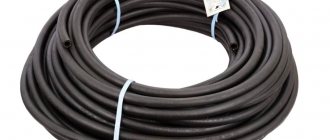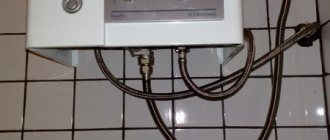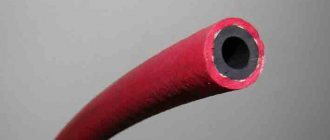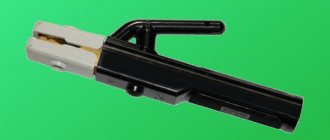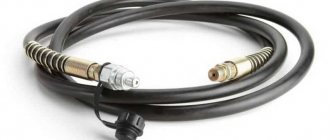Previously, in Soviet times, this issue was not considered, because the slabs were mounted to the gas pipeline using steel pipes. The reliability of this method was beyond doubt, but it also had a huge drawback: the household appliance turned into a real monument that could not be moved in any way. Now the situation has changed, and flexible products that allow housewives to easily reach hard-to-reach places can be bought everywhere, but a problem has arisen - a variety of gas hoses for gas stoves: which one is better to choose so as not to fear for the lives of yourself and your household?
What varieties can you buy?
The market offers many different models of these movable connections, but the main types for gas supply are the following products:
The materials used for their manufacture have different technical characteristics and, of course, acceptable service life. Each gas hose has certain advantages, but they are not without disadvantages. Therefore, when choosing a particular hose, it is necessary to evaluate the specific situation, the location of the gas stove, as well as the features of this equipment.
Reinforced hoses: polymer, rubber, steel
Polymer materials are located inside such a hose. The next layer is vulcanized rubber. On the outside, it is braided with steel threads. In order not to confuse the products with similar water hoses, a yellow thread is woven into them.
Reinforced hoses are quite popular, the reasons for which are:
- simple installation and ease of operation;
- reliability and decent shelf life;
- variety of assortment - both in diameter and length;
- safe use at temperatures from -35° to +50°.
Let us also note a significant disadvantage - the unimportant level of electrical insulation, the culprit of which is the metal braid. Therefore, when installing, you usually have to insert a dielectric coupling between the plate and the supply line. There is another drawback - the unreliability of the internal polymer material. For this reason, they have become “persona non grata” in some European countries, and recently the same trend has been emerging in our country.
Rubber-fabric hoses: the price is captivating
The cheapest on the list, but still this hose has some great qualities:
- the level of electrical insulation is high;
- the richness of the assortment allows you to choose products for any pipe;
- the ability to easily trim the hose based on needs.
And there are also disadvantages:
- the permissible temperature range is lower than that of reinforced components;
- the level of rigidity leaves much to be desired;
- not so long service life (5-10 years).
Another disadvantage is the rapid wear of rubber, so cracks may soon form on the products, threatening gas leaks. It is recommended to change such hoses every 2 years. But we must add that recently elastic components have been introduced into their composition that can extend their safe life to 5 years.
Manufacturers
Today, bellows liners can be purchased from both domestic and foreign manufacturers. One of the main Russian manufacturers is, which has registered the Monoflex trademark. The quality of this company's products is guaranteed by foreign technologies used in the production process. Products under the brands “Akvatekhnika” and “Flexiline” have also proven themselves.
Also, a budget version of the bellows is offered by the company Zurflex from Belarus. At an affordable price, the quality of this brand’s products can be compared with large European manufacturers, for example the German company Witzenmann. The traditional quality and reliability of the products of this company, located in Germany, is represented not only in bellows wiring, but also in other types of various plumbing equipment.
One of the leading suppliers of water wiring at the moment is the Turkish company Ayvaz, whose equipment has virtually no competitors in terms of technical parameters. Their wiring is reliable, durable and has a thoughtful design that eliminates unnecessary elements. The Italian companies Emiflex and Idrosapiens are the undisputed leaders in the market of flexible gas lines. The bellows hoses of these companies in Russia are certified by Rostest and Gosgortekhnadzor. The service life of such eyeliners is up to 15 years or more.
Often on the market, under the logos of world brands, you can buy fakes from China. There are two categories of Chinese equipment:
- products manufactured in China under official orders from European companies;
- wiring made by pirate method.
In the first case, the customer company transfers production to China to reduce costs due to the low cost of labor and materials. In the second case, the quality of the product leaves much to be desired, which can lead to leakage of water and gas. Also, one should not exclude the presence of various dangerous chemical and even radioactive compounds in the product. Price, unfortunately, is not a guarantee of product quality, so you must carefully study all products and request photocopies of the necessary certificates.
Bellows hoses: the favorite among specialists
The greater reliability of bellows hoses is the reason for their indecently high price. They are made of stainless steel and covered with polyvinyl chloride on top. These products can guarantee your safety for 25-30 years, and this figure is an average value.
The corrugated surface and metal braid provide protection from mechanical damage, and resistance to chemicals and electrical insulation are provided by the PVC coating. Let's list all the advantages:
- Widely used to connect any equipment;
- impressive temperature range - from -50° to +200°;
- ability to withstand pressure of 6 atmospheres;
- guarantees preservation of tightness even in extremely unfavorable conditions.
The only downside is the price, which is 5 times more than other hoses. But if we take into account the service life and ultra-reliability of these hoses, then we can assume that the product will quickly pay for itself.
Professional advice on choosing a gas hose
Before buying eyeliner, you should familiarize yourself with the rules, which can help in choosing the optimal equipment, as well as ensure the absence of potential troubles:
- Such products must be purchased in specialized stores. It is better to inquire in advance about the quality certificate of the product you like.
- A thorough inspection of the hose for damage is required.
- The hose diameter must be at least 10 mm; this value will ensure optimal gas pressure.
- It is strictly forbidden to buy products from Chinese manufacturers, as there is a risk of “running into” a fake. In addition, they do not have a long service life.
- The attached hose should not be in a very stretched position, so it is better to buy a longer product than vice versa.
- A stove with electric ignition requires the mandatory purchase of a dielectric coupling.
- At the ends of the hose there are 2 parts: a fitting with an external thread, and a nut with an internal thread. Therefore, the thread is selected based on the characteristics of household appliances. If the outlet pipe is straight, then you will have to buy an elbow fitting.
If there is a strong desire to save money, then the choice may fall on a regular rubber hose. Then you will have to carefully monitor its safety, and if cracks are found on it, you should replace it immediately. It is better to ask a specialist in advance about the advisability of purchasing a reinforced hose. The best option would be an expensive but reliable bellows option. But in this case, pay attention to the quality of the connecting elements - adhesive components are not allowed in them.
Features of self-installation of flexible eyeliner and care for it
After installation, the hose must be in a visible place and freely accessible. Before installing the product, you should check the integrity of the corrugation and fastening, because defects may appear during transportation or as a result of improper storage.
Having installed the bellows liner, it should be in a visible place so that free access is provided to it.
When tightening connectors, do not use excessive force or use gas wrenches, as this can strip the threads or damage the product. It is recommended to use an adjustable wrench to tighten the nuts. Other rules to follow during installation:
- Do not twist or bend the cable too much. You need to understand that you can only stretch the hose before installation; after installation, it is prohibited to increase the length of the product.
- After completing the installation of the hose, you need to open the water and monitor the condition of the connections for 5-10 minutes. Then, using a light, dry cloth, check the joint for dryness; if drops are detected, you need to re-tighten the union nuts.
The main problems that may arise during operation are mainly associated with the purchase of a low-quality product, and low-quality products are not always characterized by a low price
Therefore, it is necessary to pay attention to the appearance of the finished product and the quality of the joints made.
Another problem that leads to water leakage is weak compression of fitting connections. To avoid purchasing of dubious quality, hoses should be purchased only from certified points and only from sellers who can provide documents for the product.
Replacing the hose yourself is not a problem, the main thing is to choose the right hose that meets all the parameters
High-quality products can be operated at temperatures above 100 °C, which allows them to be used as a heating supply. Thanks to the high-quality materials used in production, the hoses are resistant not only to temperature, but also to pressure changes. Even in the event of a sudden supply of water under high pressure, as a result of which water hammer is possible, stainless steel bellows guarantee the preservation of the integrity of the shell.
Bellows flexible water supply is considered a modern option for connecting plumbing fixtures and household appliances that require access to a central water supply.
What do you need to consider for connection security?
Gas is not something to joke about, so it is better to entrust the work to a professional who is familiar with all the nuances. But if you familiarize yourself with the basic rules, you will be able to control its work from the outside, and when the opportunity arises, you will be able to show off the knowledge you have acquired. So:
- In order not to encounter problems in the future, you need to estimate in advance how far you are going to pull out the stove in case of, for example, cleaning. The length of the required hose depends on this.
- The product must be visible so that it can be constantly checked.
- Excessive tension, bending and twisting are unacceptable.
- Exposure to high temperatures is excluded.
- The elements are connected to each other only this way: copper to brass, steel to steel.
- They are tightened tightly, but not too enthusiastically, otherwise the thread may be damaged.
Read also: Do-it-yourself thyristor power regulator circuit
Now you have learned about gas hoses for gas stoves: which one is best for you? If you value reliability and durability, then there is only one way out - buy a bellows product that will provide you with safety, and therefore comfort for a long time.
Please check out this review:
In the last century, the connection of gas stoves was carried out only by laying steel pipes, which was fully consistent with the current rules for the installation and operation of gas equipment. The slab was installed rigidly - it was no longer possible to move it. With the advent of imported household appliances and accompanying accessories, flexible products began to appear in specialized stores selling gas stoves, which were a curiosity for our consumers. But over time, a hose for connecting a gas stove appeared in almost every home and became an alternative to steel pipes due to its obvious advantages and convenient use.
Connection
Gas hoses can only be installed openly or in a groove. Before starting work, make sure you have the following tools and consumables:
- screwdriver;
- adjustable wrench;
- a solution of soap, gel or washing liquid in water and a brush;
- sealant (Loctite or Fum tape);
- dielectric gaskets (for steel braided hoses).
First of all, you need to completely turn off the gas by closing the main valve of the apartment. After this, the column is mounted and secured at the installation site. Then you need to seal the connection fitting and securely fasten it on the release. Then a seal is installed on the fitting leading to the column. After installing the hose to the equipment, you need to check the tightness of the connections.
The easiest way to do this is to apply a little soap suds to the joints of the fittings and open the gas valve. If the applied foam begins to bubble, you need to close the tap and tighten the connections or add a sealant. If no changes occur with the foam, you can proceed to the last stage - checking the functioning of the equipment with connected gas.
In the next video you will find a master class on connecting a gas water heater.
Types of gas hoses
Today, the connection of gas stoves is carried out not only by government services, but also by service centers serving the public, and even by stores that sell this equipment. This became possible after the release of regulations allowing the use of such an accessory as a hose for a gas stove. The industry produces many varieties of similar products that can be used when connecting a gas stove.
- A rubber hose with a fabric braid is the most elastic flexible hose, it is soft and does not allow electrical discharges to pass through. Its installation is simple, the cost is low, and you can find samples on sale, the diameter and length of which will satisfy anyone, even the most fastidious user. There is only one drawback - low rigidity, but the service life of these hoses is designed for up to 10 years.
- A sleeve made of durable rubber with a metal braid - similar hoses are used to supply water to taps, but their inner part is made of polymers. What visual differences are there between them? The braid of gas products has a yellow thread woven into it or a similar color marking is present, while products intended for water have red and blue threads woven into it. The product is made from vulcanized rubber with the addition of a special thread inside for reinforcement. The cost is very affordable, simple installation, different lengths, can operate at temperatures no higher than +50 o C.
- Bellows hose - experts gave this name to this product because of the corrugated shell, which protects the inner hose from mechanical damage. This product is considered the most reliable of all hoses used to connect household appliances to the gas pipeline - stoves, water heaters or individual heating boilers. The service life is calculated to be up to 25 years; in the store you can choose which sample you need, depending on the location of the connected object. It costs more than other products, because the braid is made of corrugated metal; the price is also affected by the length, which has many variations.
Attention! Any user can replace the hose, but connecting the stove to the gas pipeline is a very responsible process; in the event of a leak and fire, the consequences will be very disastrous. Entrust this matter to professionals.
AQUAPROF bellows-type water liner: main advantages
A much longer service life is perhaps the most important advantage that this water liner has compared to its predecessor - a traditional braided liner with a rubber tube inside. The average service life of a metal spiral eyeliner is 25 years, while a braided eyeliner, depending on the manufacturer, can boast a maximum of 10 years. The second advantage is that the flexible water line AQUAPROF has higher performance characteristics. In particular, it painlessly tolerates high pressures in the system (including water hammer), and also has a much wider range of operating temperatures - up to +150 degrees Celsius. And this value is actually limited by the temperature resistance of the rubber gaskets that come with the kit. When using, for example, fluoroplastic gaskets with an operating temperature of up to +260 degrees, the temperature limits for using metal hose liners are significantly expanded. Thus, in essence, this liner is a 100% flexible liner for hot water. The third advantage (not in importance, of course, but simply in the order of listing): this eyeliner, due to its design features, is devoid of many “sores” inherent in traditional eyeliner. Structurally, the bellows water line is a metal spiral hose made of high purity food steel. The end parts are usually made of brass. Union nuts are threaded onto a metal hose, after which the hose is flared. The fittings are attached to the metal hose using a special technology, carefully protected and patented by each manufacturer. Thus, the bellows-type liner is devoid of both a crimp sleeve and a thin-walled nipple. It is these two parts that are the weakest points in a traditional braided eyeliner. Due to poor-quality crimping of the sleeve or incomplete insertion of the end piece shank into the hose, the hose under pressure with water is pulled out from under the sleeve. In turn, a thin-walled brass nipple simply breaks in half if the flexible water line is installed incorrectly (the minimum bending radius is violated or the length of the line is incorrectly selected, the installation is carried out “pull”), or if the nipple is made from low-quality brass (inappropriate chemical composition leads to corrosion, or in the already thin wall of the nipple there are voids, so-called “sinks” - the latter happens when using recycled materials). Fourthly, in a conventional braided liner, the rubber tube itself can act as a source of contamination of the water passing through it, if the tube is made of low-quality toxic rubber. Therefore, metal spiral eyeliner is more hygienic than traditional one.
Advantages of a bellows hose
- This product bends very easily, but at the same time it can withstand up to 6 atmospheres and can function at temperatures from -50 to +200 o C.
- The outer braid is made of stainless metal, which meets all GOST standards, as well as technical requirements for everyday use.
- An electrical insulating layer made of polymers guarantees reliable protection from any mechanical impact and high-frequency currents (there are household appliances in the kitchen, such as microwaves).
- The strength of the hose guarantees the integrity of the connection in various extreme situations, such as in the event of an earthquake.
- The service life is impressive - about 30 years from the date of installation.
- Resistance to electric current - up to 1.5 kW.
With all its positive qualities, there is only one negative point - the cost, which is five times higher than any other similar product . Polymer-coated bellows hoses are resistant to various acids contained in chemicals that housewives use to clean and disinfect the kitchen. Experts assure that such products can work in almost any conditions - similar coatings are used in production, where serious measures are needed to protect against aggressive environments.
If you have a stove with electric ignition, then special connections must be installed between the gas supply valve and the bellows product to ensure reliable insulation.
How to choose a hose
When purchasing any hose that is used to connect the stove to the gas pipeline, you must follow the recommendations of specialists.
- It is necessary to purchase products in special stores that sell certified products.
- Under no circumstances should you buy Chinese products - even with a certificate of suitability, they do not meet safety requirements, because the hoses are made of thinner rubber, which wears out very quickly. Counterfeits are very difficult to distinguish visually.
- Any type of gas hose should have a yellow mark on it, indicating that it is intended for a gas connection, and not for water, where the marks are red and blue.
- Products have lengths from 1.5 to 4.5 m, various diameters and threaded ends of half and three quarter inches. Only nuts or a nut and a fitting can be installed at both ends - it depends on where this type will be used.
When purchasing, check the hose visually for mechanical damage, scratches, cracks, even if the seller is against it.
Safety regulations
Many users are completely incompetent in these matters, so it is our duty to remind them of the safety principles:
- the hose must be constantly accessible and visible - it must not be covered with foreign objects;
- In addition to it, only a wire for lighting in the oven should be connected to the stove;
- paint cannot be applied to its surface;
- the hose, when connected, should sag freely and not be in a tense position - this may cause it to rupture;
- when purchasing and installing this product, calculate in advance how far you will move the stove during general cleaning or when rearranging furniture in the kitchen, taking into account that its maximum length is no more than 4.5 meters;
- do not allow the product to bend or twist;
- It is better to replace the hose a little earlier than its service life, without waiting for a gas leak with negative consequences to occur.
Read also: How to pour oil into a rotator
When repairing a gas pipeline using welding, the product must be turned off, and the stove must be moved to the maximum distance, covering its back with a piece of durable fabric to protect it from sparks. The more carefully you use the hose, the more secure your kitchen will be. The rules for operating gas stoves are described in detail here. To reinforce the above, watch this video:
Gas hose, it would seem, what mystery could there be in this simplest product? Come to any hardware store, take it and go to the checkout. However, have you ever wondered what is the difference between a gas hose for a gas stove and a gas hose for a boiler?
And the most important thing is that on the shelves of large retail chains such as Leroy Merlin or Maxid, this product is presented in a huge assortment. The question inevitably arises: which gas hose is better to buy? On one tray there is a PVC gas hose reinforced with polyester thread, on the other there is a bellows-type gas hose, and even lower down there is a rubber hose, and how can you not get confused?
More recently, literally a couple of decades ago, you would not have worried about the question of how to connect a gas stove. All gas household appliances, after purchase, were “tightly” and securely connected, as a rule, by the foreman of their nearest housing office using a steel pipe. Of course, we didn’t even think about aesthetics or design. There was only one task - to start using the new device as soon as possible.
Connecting with a steel pipe undoubtedly has a number of advantages. Requirements such as strength, reliability, and safety are 100% ensured. There’s just one small inconvenience: the housewife most likely won’t be able to wash the floor under the stove for the next twenty years. And it’s impossible to find kitchen furniture of the right size, so there remains 20 centimeters on each side of the stove, but it is not possible to move it. Finally, this kind of problem is a thing of the past, and there has been no shortage on the domestic household market for a long time, and flexible gas supply is offered in a wide range.
Choosing a gas hose for a stove, water heater or boiler is a very serious step. The lives of many people depend on its strength, reliability and safety. Often, the result of an illiterate connection of a stove or gas water heater to communications is an explosion. For flexible supply of natural gas, only special gas hoses are used. It is strictly prohibited to use tap water for this purpose.
Of course, it is better to call a specialist who will provide a professional connection and give a guarantee. Each of us has seen in the news what household gas explosions lead to, including as a result of unqualified connections of household gas appliances. We know from childhood that we cannot joke with gas. However, a modern gas hose allows you to make the connection yourself. Adhering to basic safety rules, any adult man can perform such a procedure.
So, let's go to the store. Let's see what the seller offers there, which flexible gas hose to choose and buy for a gas stove? It turns out there are three main types of gas hoses used in everyday life:
- – rubber-fabric;
- – reinforced rubber;
- - bellows.
How much does it cost to connect a gas stove: is it possible to install it yourself
When installing the stove, you need to choose the right hose taking into account the features of the gas tap. Depending on this, the connection can be either a nut-fitting or a nut-nut. Some gas stoves are distinguished by the presence of several inlet pipes, although only one is used - in this situation, the excess outlet is closed with a plug. The price for connecting a gas stove in Moscow from certified technicians starts from 1,300 rubles for a stove and from 1,500 rubles for a built-in hob.
The price for connecting a gas stove from certified technicians starts from 1,300 rubles.
If you have not previously had experience connecting a stove to a gas pipe, it is better to entrust this matter to professionals. In any case, it is important to adhere to basic safety rules:
- The hose should be located in a visible place so that damage can be observed. It must not be covered with furniture or household appliances.
- It is only permissible to place a wire near the product that provides illumination or electric ignition of a gas appliance.
- Do not paint the surface of the gas hose.
- Parts made of metal must be protected from condensation and moisture, which can lead to oxidation of the product.
- Do not connect hoses made of different materials to each other.
- After installation, a little sagging is acceptable, but there should be no tension.
- The device must not be kinked or twisted.
- The connections must be tightened tightly, but without excessive force, so as not to strip the threads.
- It is better not to use the hose for an extended period - it must be replaced after the time specified in the passport.
When installing the stove, you need to choose the right hose taking into account the features of the gas tap.
On a note! It is recommended to periodically apply a soap solution to the hose and joints to prevent damage and possible gas leaks.
Choosing a gas hose to connect a stove or water heater is a serious task, the competent execution of which determines the safety of not only the family, but also the entire residential building. The service life of the product depends on how high-quality the hose is chosen and on the correctness of its installation. It is very important to pay attention to the markings so as not to accidentally use a water hose to connect the gas. If you lack experience, it is better to entrust the selection and installation to professionals.
Rubber gas hose.
The softest of all types of hoses are rubber hoses reinforced with textile thread. They have long gained a reputation as an unpretentious compound, and are often found in the household of a thrifty homeowner. Simple installation work, low cost, flexible properties and functionality are attractive qualities that determine popularity. There are always options on the shelves with different lengths and diameters.
Rubber is one of the best dielectric materials. They are used to supply liquefied gas from gas cylinders to household appliances and are used in dachas and private homes. This method of flexible gas supply is the simplest and cheapest, but also the most dangerous .
The big disadvantage is that over time, cracks form in the rubber, leading to gas leakage. The only place where it is permissible to use this type of flexible connection is gas cylinders in the private sector. Among other things, the products lack the necessary rigidity.
It is not recommended to use rubber fabric sleeves for more than two years, but in practice they last much longer. However, modern rubber hoses are made with elastic components that allow the product to be used for up to 5 years.
Kinds
Currently, there are 3 main types of gas supply hoses that are most common, namely:
- rubber or fabric;
- polymer in metal braid;
- bellows.
Let's look at the advantages and disadvantages of each option in more detail.
Hoses made of rubber or fabric
In such products, textile thread is used as a reinforcing element. Due to the fact that metal in such products is used only for fittings, they cost noticeably less than other gas hose options
Another important advantage of such options is the absence of metal along the length of the hose, which makes it an excellent dielectric and reduces the risk of explosion in case of accidents and leaks
The main disadvantage of this option is its noticeably lower strength than that of more expensive products. In places where such a hose is bent, small cracks appear quite quickly. Therefore, such a product sometimes has to be replaced after two years of operation.
Metallized models
Due to the presence of a protective sheath made of metal fibers, such a hose is noticeably stronger than rubber or fabric. However, this option also has a number of important disadvantages:
- such a sleeve has end-to-end electrical conductivity, so for its installation it is necessary to use dielectric gaskets;
- the braid does not allow visual detection of damage to the polymer “filling”.
Bellows hoses
Such hoses consist of a base of steel sections braided with polymer or metal. All of them are highly durable and reliable. Options with polymer braiding additionally have dielectric properties, and products with steel braiding are the most reliable options available. The main disadvantage of such hoses is their high price.
Reinforced gas hose.
The most common are rubber reinforced hoses that look like hoses for water supply. On the outside they are braided with steel threads. Although they are called rubber, they contain a polymer material inside. The easiest way to distinguish a gas hose from a water hose is by the color of the threads woven into the outer braid; they should be yellow.
Metal braided hoses are inexpensive and easy to use, but some European countries have banned their use. In our country, gas workers also recommend gradually abandoning them or using them with precautions.
The plastic hose inside is subject to the same destruction and destruction as rubber. In addition, steel is a good conductor of electric current, so the connection must be made with the mandatory use of dielectric gaskets.
Stainless steel bellows type gas hose.
Bellows-type hoses are the only ones approved by gas services for household gas appliances. What is a bellows? This is a corrugated, durable and dense shell that retains its properties when exposed to temperature, pressure and severe mechanical load.
The bellows takes its name from the English. branded Sylphon. It comes in single- and multi-layer types, and is made from both metallic and non-metallic materials. The shell serves as a barrier and gives the product increased safety.
Bellows flexible hoses are made of stainless steel. They come in two types. The first in a metal braid without insulation, this type is suitable for ordinary stoves with traditional ignition from matches. If your modern gas stove is equipped with electric ignition and is connected to the electrical network, then you should not bother looking for a dielectric gasket.
It is easier to turn your attention to the second type with a yellow polymer coating, which is reliable electrical insulation. This type of protection is especially relevant for gas stoves equipped with various electrical components - electric ignition, lighting, electric grill. The polymer coating is durable, strong, reliable and guarantees absolute electrical insulation.
Read also: How to make a voltmeter from a milliammeter
For uniform gas supply, an internal hose diameter of at least 10 mm is recommended. The advantages of using bellows hoses are undeniable. Samples with a plastic coating, which guarantee excellent protection from various disasters, have proven themselves especially well.
Bellows hoses have a service life of up to 30 years. Their only drawback is their high cost compared to other types of gas hoses, but here, as they say, safety is more expensive! Moreover, the increased cost as a percentage will be negligible compared to purchased gas equipment.
Bellows hose for gas, advantages:
- The gas hose is manufactured in accordance with technical specifications and satisfies GOST regulations;
- The only one approved for use by government services;
- Component PVC coating provides the product with reliable protection. Polymers are highly resistant to aggressive environments and mechanical shocks.
- The gas supply line often remains undamaged, subjected to significant and sometimes critical loads;
- Manufacturers set a long service life for the product, more than 25 years;
- PVC protects against electrical influences of 1000 V or more.
- There are no regulations regarding restrictions during operation.
How to choose the right gas hose
The main advice sounds quite banal: a gas hose without emergency consequences can be bought at any specialized store where you will be provided with a state certificate of conformity. When answering the question: which gas hose is better, bellows or rubber, opt for the first. And of course, beware of cheap Chinese counterfeits or from other countries that do not care about the company’s reputation. On the street market you can find high-quality fakes in which:
- gas hose made of very thin rubber, subject to rapid wear; - many fakes are completely indistinguishable in appearance from real ones, especially if you are an ordinary buyer and not a professional gas service employee
Don’t forget to check for the presence of a yellow mark on the hose braid; this is what indicates that you have a gas hose in your hands, and not a water supply line with a blue-red mark. It is not worth buying a gas hose with a “reserve”, first take the necessary measurements and add 20%, this length will be enough.
The manufacturer offers different lengths, but the most popular are one- to two-meter options. The standard diameters used in everyday life are 1/2 or 3/4 inches. The gas hose is equipped with two union nuts with internal threads (American or in common parlance, mother-mother). The second type of hose, when there is a nut at one end and a male-threaded bushing at the other - “male-male”.
Features of choosing the best hose
It is advisable to purchase hoses for supplying gas to household equipment in specialized stores that can provide a quality certificate for each product.
The range includes models of different lengths. It is selected so that in the future you do not have to connect several tubes to each other.
The most commonly used tubes are 1, 1.5 and 2 meters. This reduces the risk of line ruptures and, accordingly, increased danger for apartment residents. If the length is not enough, the supply is supplemented with a metal pipe.
Another important indicator is the cross-section diameter. The minimum value that will ensure good cross-country ability and full gas supply to the device is 10 mm.
The ends of the hoses are equipped with two nuts or one nut and a fitting. The nut has an internal thread, the fitting has an external thread. The thread is selected in accordance with the outlet on the household appliance. If the outlet is direct, then a special fitting-angle is used.
Professionals advise buying hoses with sufficient length (sleeves up to 4.5 meters are available for sale). This approach will allow you to choose any convenient place for the equipment and simplify installation, freely performing the installation without excessive tension
An ordinary rubber-fabric hose will do as a budget option. When choosing this product, you need to carefully monitor the degree of wear.
If the slightest cracks, damage or smell of gas is detected, replace it in a timely manner. When looking for an offer that would optimally combine price and quality indicators, it makes sense to focus on reinforced hoses.
In order for the gas to reach all burners on the stove in the required volume, the diameter of the gas hose must be at least 10 mm. The bigger it is, the better
If finances allow, it is better to take a bellows hose. It is recognized as the safest and most reliable device - officially approved for use with household appliances by city gas services.
When choosing it, you need to check the type of connection. Its quality directly affects the durability of the product. It is not advisable to take models in which the fitting is connected to the corrugation using glue. It is more advisable to find a solid or welded structure.
Connecting the gas hose to the stove
After purchasing a suitable product option, we eagerly move on to the steps of connecting the hose to the new stove. We find a fitting at the back of the plate, usually with an external thread. This is the gas supply inlet. Slab manufacturers complete their products with a straight or angular receiver, depending on the model.
If you get a device with a direct entrance, we recommend purchasing a brass corner with internal threads and a boundary wall into which a paranitic gasket is inserted. When installing, avoid sharp bends in the hose.
Imported slabs are sometimes sold with 3/8 or 3/4 inch threads at the outlet. There will be no tragedy if you additionally purchase a regular “futorka” adapter for the commensurate threads of your gas hose in advance. In residential buildings, the gas riser is usually installed in one of the corners of the kitchen area. There is an outlet from it for your use; a gas tap must be installed on it. We will screw or screw our gas hose onto it, depending on what thread the valve is equipped with.
As standard, the gas hose comes with two paronite gaskets. Remember to use them when connecting, this will make it easier for you to ensure that there are no leaks. They also advise using a gasket purchased separately with a fine mesh; experts claim that it will help get rid of various types of contaminants. But we leave this procedure at your discretion, since gas usually flows without mechanical inclusions.
The gas hose is screwed on with a wrench, but do not overdo it and do not squeeze out the paronite. After the work has been completed, it remains necessary to carry out a mandatory check for possible gas leaks. It is enough to apply soap suds to the connections; the absence of air bubbles indicates that the work was done efficiently and the stove can be used. Bon appetit!
Maintaining Basic Safety
- The main requirement of the gas service is access to the supply line, so the flexible hose for the gas stove must be within reach;
- It is not allowed to have third-party connections to the gas stove;
- The gas hose must be kept clean, embellishment is not allowed, it cannot be coated with paint, or other “improvements” in appearance are made;
- The eyeliner should have a natural sag. Tension is fraught with a break in the hose, or gas leakage at the points of connection to the fittings;
- If you plan to move the stove before general cleaning, calculate the required length of the gas hose in advance. Be sure to close the ball valve before moving;
- Avoid excessive bending or twisting;
- It is necessary to protect the metal braid from condensation;
- Do not weld or solder the connection, use only the threaded joining method;
- Replace the old gas hose with a new one in a timely manner, in accordance with the service life established by the manufacturer.
We really hope that our review helped you decide and understand which gas hose for a gas stove is best to choose. Now you definitely won’t get lost in the store, since you have learned the specific features and differences between gas hoses. Self-connection will also not take much time if you have the necessary tools.
However, please note that a number of manufacturers do not allow the owner of the equipment to perform such work. One of the requirements is increasingly becoming the condition for connecting devices by specialists of an authorized gas service. Otherwise, there is a risk of losing the warranty. Check the operating instructions to see if you will lose the warranty on the stove if you connect it yourself. If not, we wish you good luck!
We offer you an entertaining video review, where channel 1 recommends which gas hose is best to use at home:
What is a hose for a gas pipe: the main requirements for the product
In appearance, the hose for connecting a gas stove is very similar to a water supply. The main difference between a gas device is the presence of yellow or white markings, which should be visible. In addition, the flexible hose for the gas stove is made of a special material. Another feature is the presence of a paronite gasket - a special ring that is used to seal the flange connection. It is the presence of the gasket that ensures the safety of using the products.
In appearance, the hose for connecting a gas stove is very similar to a water supply.
Note! If you are wondering what kind of hose is needed for a gas stove, then the main component here is the presence of the appropriate markings and a certificate issued by Rostechnadzor of Russia.
This document confirms that the product meets safety requirements. In addition, the hose must be accompanied by a passport indicating the date of its manufacture. Purchasing a high-quality and certified product will ensure the safe use of gas, but purchasing a hose of dubious quality without the appropriate documents can lead to tragedy.
Other mandatory requirements for a flexible gas hose for a stove:
- The product must be complete, without additional couplings, extensions or connections.
- It is necessary that the flexible liner have a special coating that is resistant to hot liquids and high temperatures.
- The hose must not be subject to corrosion.
- The parameters of the product must correspond to the characteristics of the gas used.
- The service life of a gas hose for a gas stove should not be less than 10 years.
It is unacceptable to connect several hoses together - it is better to immediately purchase a hose for a gas stove, the length of which will correspond to the distance between the gas pipe and the hob. The maximum length of a gas hose for connecting a stove according to European standards is 2 meters, although a seven-meter hose is considered the longest certified product. If you look at the relevant Russian GOSTs, you will notice that they do not contain recommendations regarding the length of the gas hose. In any case, you should not install the stove too far from the gas pipe.
The main types of hoses include: oxygen, reinforced rubber, rubber-fabric, reinforced PVC hoses, bellows.
Now the market offers a large number of different options for mobile gas connections. The materials used in production also differ in technical characteristics that affect their service life. Therefore, in order to understand what the hose for a gas stove should be like in a particular situation, you need to take into account the location and features of use of the hob.
The main types of hoses include:
- oxygen;
- reinforced rubber;
- rubber-fabric;
- reinforced PVC hoses;
- bellows.





